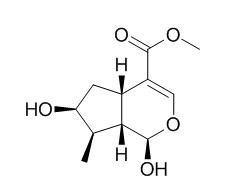Loganetin
Standard reference
Inquire / Order:
manager@chemfaces.com
Technical Inquiries:
service@chemfaces.com
Tel:
+86-27-84237783
Fax:
+86-27-84254680
Address:
1 Building, No. 83, CheCheng Rd., Wuhan Economic and Technological Development Zone, Wuhan, Hubei 430056, PRC
Providing storage is as stated on the product vial and the vial is kept tightly sealed, the product can be stored for up to
24 months(2-8C).
Wherever possible, you should prepare and use solutions on the same day. However, if you need to make up stock solutions in advance, we recommend that you store the solution as aliquots in tightly sealed vials at -20C. Generally, these will be useable for up to two weeks. Before use, and prior to opening the vial we recommend that you allow your product to equilibrate to room temperature for at least 1 hour.
Need more advice on solubility, usage and handling? Please email to: service@chemfaces.com
The packaging of the product may have turned upside down during transportation, resulting in the natural compounds adhering to the neck or cap of the vial. take the vial out of its packaging and gently shake to let the compounds fall to the bottom of the vial. for liquid products, centrifuge at 200-500 RPM to gather the liquid at the bottom of the vial. try to avoid loss or contamination during handling.
Int. J. Mol. Sci.2023, 24(20),15294.
BMC Complement Altern Med.2014, 14:242
Phytother Res.2020, 34(4):788-795.
J Cell Mol Med.2020, 24(21):12308-12317.
J Formos Med Assoc.2020, S0929-6646(20)30425-3
J Insect Sci.2020, 20(5):18.
Antimicrob Agents Chemother.2020, AAC.01921-20.
Pharmaceutical Chemistry Journal2019, 52(12):986-991
Food Bioscience2023, 53:102687
Front Microbiol.2019, 10:2806
Related and Featured Products
Biol Pharm Bull. 2012;35(4):573-81.
Metabolism of ginsenoside Rb1 by human intestinal microflora and cloning of its metabolizing β-D-glucosidase from Bifidobacterium longum H-1.[Pubmed:
22466563]
To understand the role of intestinal microflora in expressing the pharmacological effect of ginsenoside Rb1, the metabolic activity of ginsenoside Rb1 by 148 fecal specimens was measured and its metabolizing β-glucosidase was cloned.
METHODS AND RESULTS:
The average activities for p-nitrophenyl-β-D-glucopyranoside and ginsenoside Rb1 were 0.097±0.059 μmol/min/mg and 0.311±0.118 pmol/min/mg, respectively. These enzyme activities were not different between male and female, or between ages. A gene encoding β-D-glucosidase (BglX) was cloned from Bifidobacterium longum H-1, which transformed ginsenoside Rb1 to compound K. The probe for cloning was synthesized from the genes encoding a β-D-glucosidase of previously reported B. longum DJO10A. The sequences of the cloned gene revealed 2364 bp open reading frame (ORF) encoding a protein containing 787 amino acids (molecular weight of 95 kDa). The gene exhibited 99% homology (identities) to that of B. longum. The cloned gene was expressed under T7 promoter of the expression vector, pET-39b(+), in Escherichia coli BL21(DE3), and the expressed enzyme was purified by using HiTrap immobilized metal affinity chromatography (IMAC) HP. The enzyme potently biotransformed ginsenoside Rb1, loganin, arctiin and arbutin to ginsenoside Rd, Loganetin, arctigenin and hydroquinone, respectively, but was not active in the case of hesperidin, and kakkalide.
CONCLUSIONS:
This is the first report on cloning and expression of β-D-glucosidase from B. longum. Based on these findings, ginsenoside Rb1 may be metabolized to bioactive compound(s) by exo-β-D-glucosidase(s) produced from the intestinal bacteria and its pharmacological effects may be dependent on intestinal bacterial exo-β-D-glucosidase(s) activity.
Phytochemistry. 2003 Sep;64(2):549-53.
seco-iridoids from Calycophyllum spruceanum (Rubiaceae).[Pubmed:
12943773]
METHODS AND RESULTS:
Three seco-iridoids 7-methoxydiderroside, 6'-O-acetyldiderroside and 8-O-tigloyldiderroside, were isolated from the wood bark of Calycophyllum spruceanum together with the known iridoids Loganetin, loganin and the seco-iridoids secoxyloganin, kingiside and diderroside. Their structures were elucidated by means of NMR and MS spectral data analysis. Using NOE correlations and coupling constants, the relative stereochemistry of the new derivatives was established.
CONCLUSIONS:
7-Methoxydiderroside, 6'-O-acetyldiderroside and the known secoxyloganin and diderroside showed in vitro activity against trypomastigote forms of Trypanosoma cruzi, with IC(50) values of 59.0, 90.2, 74,2 and 84.9 microg/mL, respectively and were compared to the standard gentian violet (IC(50) 7.5 microg/ml).
Nat Prod Commun. 2009 Nov;4(11):1581-4.
Composition of diethyl ether flower extracts of Lonicera fragrantissima Lindl. & Paxton (caprifoliaceae).[Pubmed:
19967996]
METHODS AND RESULTS:
GC and GC-MS analyses of two diethyl ether extracts of Lonicera fragrantissima flowers (extraction times 1 and 20 days) enabled the identification of 61 components that represented ca. 90% of the extract volatiles. 10-Nonacosanol (18.1-24.1%), nonacosane (14.4-15.0%) and the rather rare long-chained fatty acid hexyl esters (octadecanoate, eicosanoate, docosanoate, tetracosanoate, hexacosanoate, octacosanoate and triacontanoate, in total 19.1-19.5%) were among the main constituents of both extracts. However, a number of differences were observed in the chemical composition of the 1 and 20 day extracts, the relative percentage of the iridoid Loganetin being the most striking (19.1 and 2.1%, respectively). To the best of our knowledge, this is the first report on the GC behavior of Loganetin.
CONCLUSIONS:
It seems that this and the long-chain fatty acid hexyl esters could have chemotaxonomic significance at the generic level.



